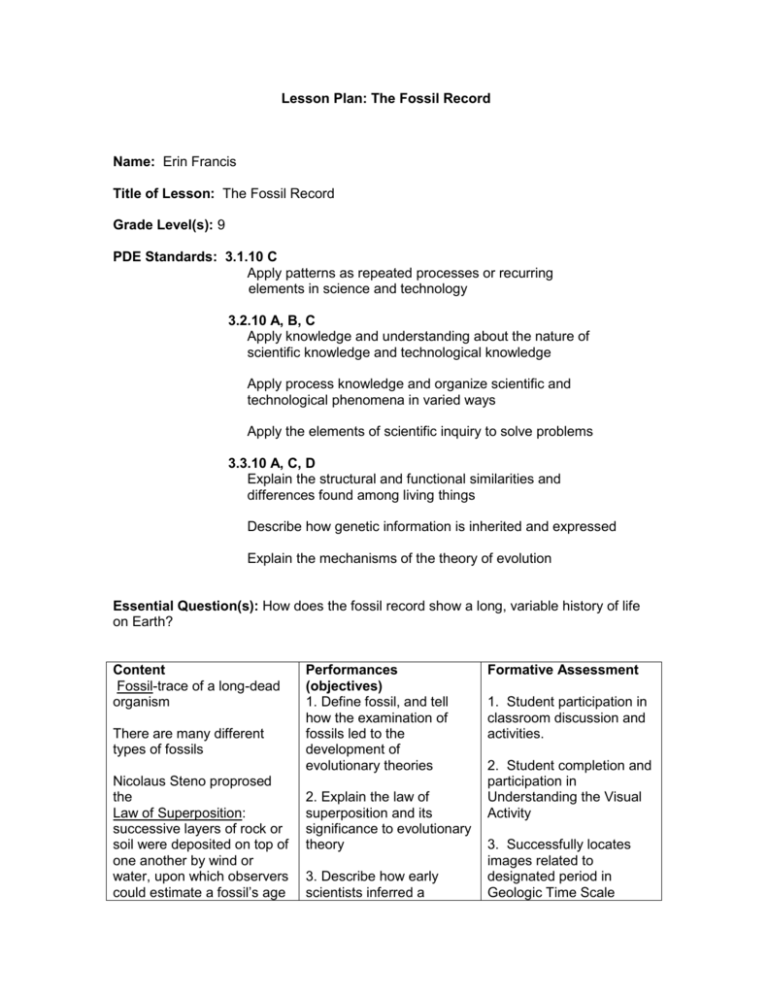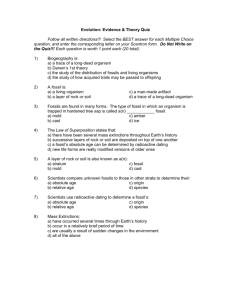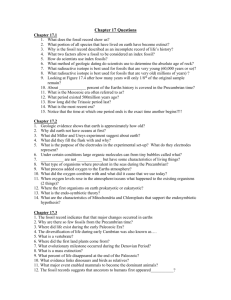Lesson Plan: The Fossil Record
advertisement

Lesson Plan: The Fossil Record Name: Erin Francis Title of Lesson: The Fossil Record Grade Level(s): 9 PDE Standards: 3.1.10 C Apply patterns as repeated processes or recurring elements in science and technology 3.2.10 A, B, C Apply knowledge and understanding about the nature of scientific knowledge and technological knowledge Apply process knowledge and organize scientific and technological phenomena in varied ways Apply the elements of scientific inquiry to solve problems 3.3.10 A, C, D Explain the structural and functional similarities and differences found among living things Describe how genetic information is inherited and expressed Explain the mechanisms of the theory of evolution Essential Question(s): How does the fossil record show a long, variable history of life on Earth? Content Fossil-trace of a long-dead organism There are many different types of fossils Nicolaus Steno proprosed the Law of Superposition: successive layers of rock or soil were deposited on top of one another by wind or water, upon which observers could estimate a fossil’s age Performances (objectives) 1. Define fossil, and tell how the examination of fossils led to the development of evolutionary theories 2. Explain the law of superposition and its significance to evolutionary theory 3. Describe how early scientists inferred a Formative Assessment 1. Student participation in classroom discussion and activities. 2. Student completion and participation in Understanding the Visual Activity 3. Successfully locates images related to designated period in Geologic Time Scale Earth is more than 100,000 times longer than recorded history The fossil record showed that brief extinctions and mass extinctions,brief periods during which large numbers of species disappeared, occurred probably as a result of drastic environmental changes succession of life forms from the fossil record 4. Completion of Review Worksheet 1 4. Tell how biogeographic observations suggest descent with modification Biogeography-study of the geographical distribution of fossils and of living organisms, compares fossil types with living organisms in the same geographic area Essential Elements of Inquiry addressed: Essential Element A, Level 1 and 2 Essential Element B, Level 1 and 2 Essential Element C, Level 2 Essential Element D, Level 2 Essential Element E, Level 1 Procedures: DAY ONE Lesson Beginning 1. Students copy down objectives from the board 2. Students participate in Understanding the Visual activity and subsequent class discussion about adaptation and natural selection 3. Students answer broad questions based on prior knowledge 4. Tell students that the theory of evolution states that species change over time, and the primary mechanism for this change is natural selection. Emphasize that fossils provide one line of evidence for evolution. Concept Development Think Pair Share: Partner groups are provided with fossils, pictures of fossils, drawings of extinct organisms based on fossil interpretation, and pictures of living organisms. Students will examine the materials and try to arrange them in order of their appearance on Earth. When the class reconvenes as a large group, students make note of patterns that occurred over time. DAYS TWO AND THREE -Lecture: Students take notes from Powerpoint presentation, and participate in class discussions -Visual Instruction: Students will receive a copy of Encyclopedia Britannica’s Geologic Time Scale. -Inquiry: In pairs, students will choose a specific period from the Geologic Time Scale, and, using the laptops, find two images of organisms representative of that period. Lesson Ending 1. Major concepts to summarize: Fossil-trace of a long-dead organism There are many different types of fossils Nicolaus Steno proprosed the Law of Superposition: successive layers of rock or soil were deposited on top of one another by wind or water, upon which observers could estimate a fossil’s age Earth is more than 100,000 times longer than recorded history The fossil record showed that brief extinctions and mass extinctions,brief periods during which large numbers of species disappeared, occurred probably as a result of drastic environmental changes Biogeography-study of the geographical distribution of fossils and of living organisms, compares fossil types with living organisms in the same geographic area 2. Assessment: Students will complete Review Worksheet 1 Special Adaptations/Modifications: Students with special needs will receive special assistance and be permitted more time to complete worksheet. Anticipated Difficulties/Modifications: Computer access may be hindered if system is down, in which case lesson will have to proceed without the technology portion of the lesson. Lesson may continue in school library. Physical Structure: Whole group, partners, individual work Materials: Projector White board Laptop for teacher Laptops for students Power Point Presentation Understanding the Visual Geologic Time Scale Handout Review Worksheet One Laboratory Safety reminders: No food or drink while working with laptops. Make sure extension cord is taped to floor to prevent tripping hazard. Make sure cord from computer are taped to floor to prevent tripping hazard. Lights will be off in classroom for a portion of the lesson, so advise students to move about the classroom with caution. Notes for next semester:






